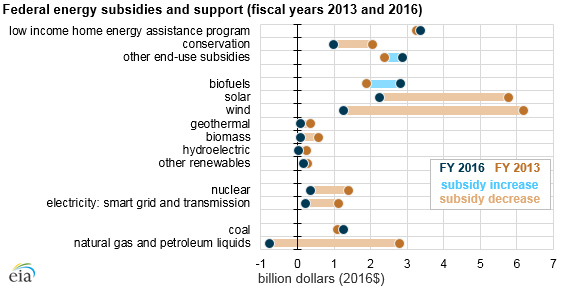Federal Energy Subsidies Declined Since 2013, Solar and Wind Still the Big Winners
The Energy Information Administration has updated its analysis of federal energy subsidies to include the fiscal year 2016 numbers. The key takeaway is that energy subsidies have fallen substantially since 2013, but solar and wind still get more subsidies than nuclear, coal, oil, or natural gas.

Spending is down dramatically because much of the money spent in 2013 was part of President Obama’s stimulus plan. On a side note, it is interesting that the so-called stimulus package subsidized expensive forms of energy that have made the United States less competitive on a global stage by driving up energy prices.
EIA notes:
“Between fiscal years 2013 and 2016, direct federal financial interventions and subsidies in energy markets decreased by nearly half, from $29.3 billion in FY 2013 to $15.0 billion in FY 2016.”
“The decrease in direct expenditures for renewable sources of electricity reflects the expired temporary government program that revised tax credits for a growing solar power industry, allowing subsidy applicants to receive grants in lieu of tax credits.”
“Wind subsidies decreased the most, falling from $6.2 billion in FY 2013 to $1.3 billion in FY 2016.”
“Federal subsidy support for fossil fuels declined from almost $3.9 billion in FY 2013 to $489 million in FY 2016. Within those fossil fuel subsidies, support for coal slightly increased, while support for natural gas and petroleum liquids decreased substantially. In FY 2016, certain tax provisions related to oil and natural gas yielded positive revenue flow for the government, resulting in a negative net subsidy of $773 million, based on estimates from the U.S. Department of Treasury.”
I’m curious to see why wind subsidies have fallen so much, according to the new report. I’m actually taking the rest of the day off to drive to Milwaukee to see a John Prine concert with my mom, but I’ll have a more detailed breakdown of the subsidies in the near future.